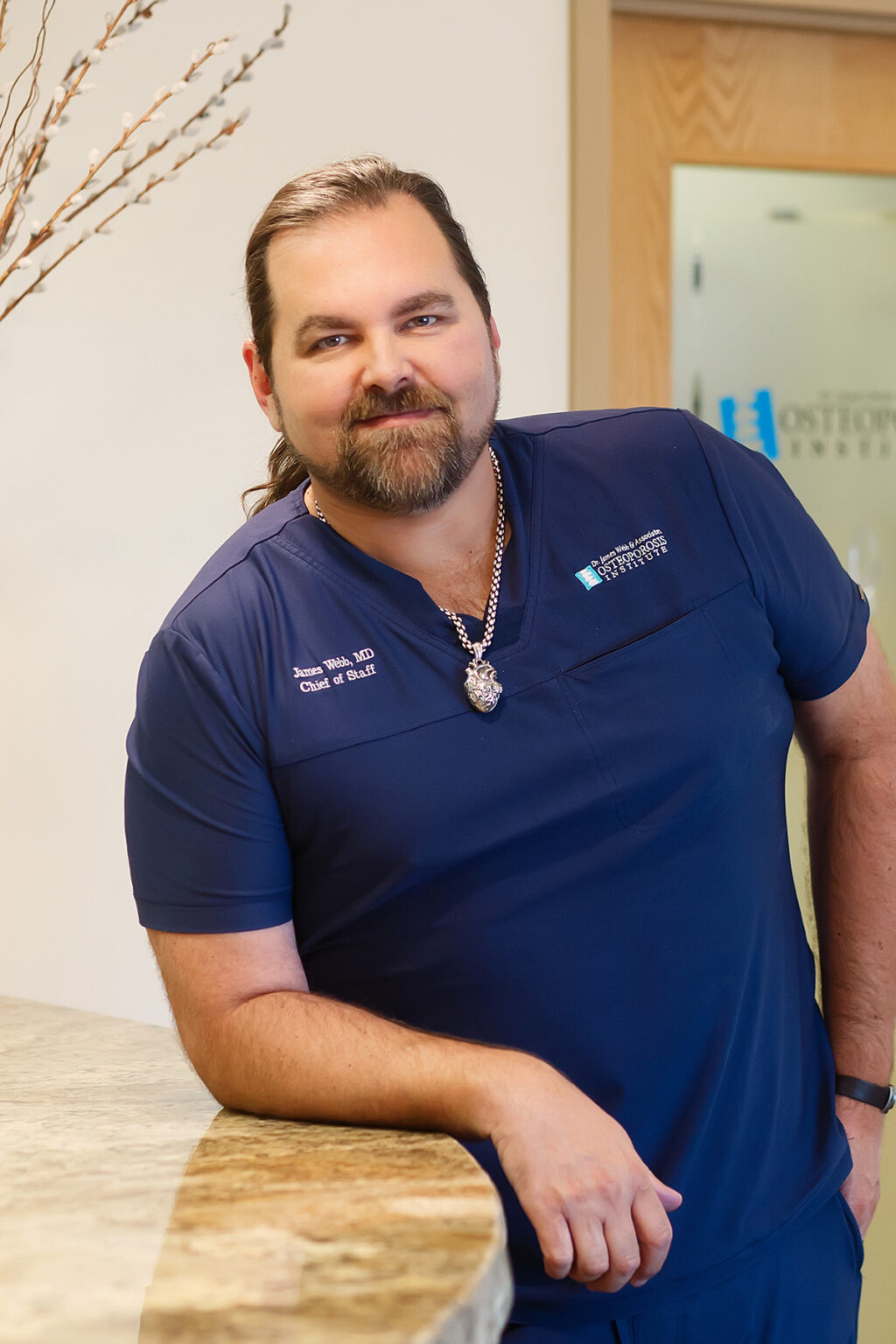Pain Management Tulsa
 Dr. James Webb specializes in pain management and pain treatment in Tulsa. Do you have neck or back pain on your spine? Or pain that radiates around your rib cage, hips or legs?
Dr. James Webb specializes in pain management and pain treatment in Tulsa. Do you have neck or back pain on your spine? Or pain that radiates around your rib cage, hips or legs?
You may be wondering if you have osteoporosis, osteopenia, spondylosis, spinal stenosis or some combination of other back problems causing pain.
BOOK AN APPOINTMENT with Dr. James Webb & Associates to get a clear diagnosis and a path forward – to restore mobility and significantly reduce pain.
What to Expect
Your visit to Dr. James Webb & Associates begins with a thorough examination of your medical history, along with a review of recent imaging and bone density scans. If you have not had recent imaging, we will arrange for an MRI or CT scan. Dr. James Webb & Associates provides in-house bone density tests. Your office visit will include a physical examination to accurately diagnose the source of your pain.
After determining a clear diagnosis, we will present a treatment plan that helps manage your pain and work toward improved bone health in the future.
Pain Treatment Procedures
Kyphoplasty
What is Kyphoplasty?
Kyphoplasty is a minimally invasive medical procedure that can repair spinal fractures (vertebral compression fractures) and restore structural integrity to spinal vertebrae. Kyphoplasty is an outpatient procedure that uses an expandable balloon to create a cavity and then fill the collapsed vertebrae with a special bone cement to restore the shape and strength of collapsed vertebrae.
How does Kyphoplasty help?
The goal of kyphoplasty treatment is to restore the spine to a more normal curvature and to reduce pressure on nerves. Many of our patients experience immediate pain relief following kyphoplasty. Kyphoplasty success rates for pain relief are about 94% according to the medical literature.
Kyphoplasty restores height to the crushed vertebral body and decreases spinal deformities. It can help relieve pain by stabilizing the fracture. Improved mobility results because of decreased pain levels.
What happens during the Kyphoplasty procedure?
- Instruments Inserted – Through a half-inch incision, small instruments are placed into the fractured vertebral body creating a working channel.
- IBT Inserted – The KyphX inflatable bone tamp is then placed into the fracture.
- Cavity Created – The device is carefully inflated, creating a cavity inside the vertebral body.
- Balloon Deflated – The balloon is deflated, leaving a cavity in the vertebral body.
- Fracture Stabilized – The cavity is filled with bone cement to stabilize the fracture. Once filled, the incision is closed.
- End of Procedure – With the process completed, an internal cast is now in place. This stabilizes the vertebral body and provides rapid mobility and pain relief.
The procedure takes about 30 minutes and has a short recovery time, usually a couple of days for most patients.
After Kyphoplasty
Patients treated with balloon kyphoplasty have significantly better outcomes in terms of pain reduction, quality of life, function and mobility both initially at one month, and throughout the months and years after treatment.
While kyphoplasty is highly effective for improving mobility and decreasing pain in patients with spinal fractures, it does not treat the underlying osteoporosis itself. It’s important for your doctor to treat the underlying bone disease (osteoporosis) causing the fractures. This decreases the risk of future fractures and generally makes spinal fractures less frequent.
Kyphoplasty vs. Vertebroplasty
Kyphoplasty and vertebroplasty are both medical procedures designed to treat pain associated with vertebral compression fractures. Where Kyphoplasty first uses a balloon to restore vertebral height, vertebroplasty does not. Kyphoplasty has a significantly lower complication rate compared to verteboplasty and has an added life-extending benefit as it decreases mortality.
Dr. Webb – Kyphoplasty Expert
When it comes to kyphoplasty, Dr. Webb is one of the most experienced physicians in the US. Dr. Webb has performed thousands of kyphoplasty procedures and has the experience necessary to safely perform kyphoplasty. In fact, he also teaches other physicians how to safely and effectively perform the procedure. Here are a facts about Dr. Webb’s kyphoplasty expertise:
- He performed over 120 kyphoplasties during his training (fellowship)
- Was one of the first physicians to perform kyphoplasty in Oklahoma
- Is one of a few in the nation to establish a full-service outpatient clinic focused on medically treating the underlying causes of osteoporosis
- Averages 300-400 fractures treated per year
- Continues efforts to refine vertebral fracture treatment, consulting for numerous medical device companies and teaching other physicians how to perform this life-saving procedure
- Is a principal investigator in the EVOLVE trial, the largest ever on-label study of kyphoplasty in Medicare patients with vertebral fractures with 350 patients enrolled over 24 sites across the US.
Osteoporosis Management
What is Osteoporosis Management?
The goal of medical osteoporosis treatment is to decrease future fracture risk. Osteoporosis management includes treatment of the entire disease – assessing and addressing risk factors, repairing of damaged bones, medical treatment for prevention of additional fractures and active guidance for promoting future bone health. It’s never too early to consider the risks and possible effects of osteoporosis on your life and to consider steps you can take to prevent it.
How does Osteoporosis Management help?
We are seeing younger patients suffering from osteoporosis. Many of these cases are preventable. Bone health can be significantly enhanced through nutrition and supplementation and by addressing risk factors for osteoporotic fractures such as smoking and vitamin D deficiency. Many people are surprised to learn that common medications can cause bone loss – including antacids, steroids medications, some contraceptives, blood pressure medications, anti-depressants and others.
As one of the foremost osteoporosis specialists, Dr. Webb and his team help educate you on the steps you can take to optimize bone health and minimize your risks for severe osteoporosis.
If you are already suffering from osteoporosis, we can to help reduce your fracture risk and provide ongoing management and guidance to help you get the most out of life.
Epidural Steroid Injections (ESI)
What is an Epidural Steroid Injection?
An epidural steroid injection may be used to reduce inflammation around spinal nerves, thereby reducing pain associated with pinched nerves and reducing pain commonly associated with conditions such as sciatica. During the procedure a steroid (cortisone) is injected directly into the epidural area of the spine.
How does an Epidural Steroid Injection help?
Epidural injections can help reduce the body’s inflammatory response (and associated pain) that comes with common back problems, including as herniated discs, degenerative disc disease, lumbar spinal stenosis,
What happens during an ESI procedure?
- Local Anesthetic – is applied at the epidural injection site
- Contrast Dye – is injected to confirm proper placement of the epidural needle
- Epidural Injection – epidural injection is administered into the epidural space at the site of inflammation
The procedure takes about 30 minutes.
Medial Branch Block
What is a Medial Branch Block?
A medial branch block is an injection of a strong local anesthetic on the medial branch nerves that supply the facet joints. The facet joints, also called zygapophysial joints, are part of the stability framework of the spine consisting of pairs of small joints between the vertebrae and the back of the spine. Each facet joint contains medial branch nerves that can become inflamed for a variety of reasons – osteoarthritis, spinal stenosis, trauma from a car accident or fall – and cause pain.
How does a Medial Branch Block help?
A medial branch block is primarily a diagnostic procedure used to determine if a facet joint is causing back pain and may help pinpoint the location and source of nerve pain. It may be useful in determining the next step in a treatment plan, usually rediofrequency ablation.
Radiofrequency Ablation (RFA)
What is Radiofrequency Ablation?
Radiofrequency ablation (also known as radiofrequency neurotomy) is a minimally invasive procedure through which a heat lesion is created on a nerve to interrupt pain signals sent to the brain. Radiofrequency waves are used to heat the end of the instrument used during the procedure. Targeted nerves are not involved in muscle control or feeling sensation, so the heat lesion poses little risk of affecting those areas.
How does Radiofrequency Ablation help?
Radiofrequency ablation helps by disrupting the nerve’s pain path to the brain. Typically 30 to 50% of patients will experience significant pain relief for up to two years. The remaining 50% will usually get some relief for a shorter period of time.
Bio-Identical Hormone Replacement Therapy (BHRT)
What is Bio-identical Hormone Replacement Therapy?
As we age, our bodies produce less of the hormones needed to regulate essential systems. Bio-identical hormone replacement therapy (BHRT) uses supplemental hormones molecularly similar to human hormones. Dr. James Webb & Associates administers hormone pellet therapy, through which BHRT pellets are inserted under the skin in the hip area.
How does Bio-identical Hormone Replacement Therapy help?
BHRT is an effective treatment for combating osteoporosis in both men and women and for addressing other conditions associated with low hormone counts.
Bone Density Scans
What is a Bone Density Scan?
A bone density scan (also called bone densitometry or dual-energy x-ray absorptiometry or DEXA) is commonly used to diagnose osteoporosis. It is a low-radiation X-ray used to measures bone density loss and to assess the risk of developing future fractures associated with osteoporosis. Osteoporosis associated with low bone density is known as “Primary Osteoporosis.” Patients with “Secondary Osteoporosis” can have normal bone density, but fragile bones due to conditions such as vitamin D deficiency, smoking, hormonal imbalances, diabetes, vasculitis or certain medications such as steroids, proton-pump inhibitors, blood thinners (such as warfarin or heparin) or anti-depressants known as SSRIs.
How does a Bone Density Scan help?
A bone density test in Tulsa for area residents can help them learn more about their bone health. It is an essential tool used to examine the internal strength and structures of your bones. It is an effective tool used to diagnose osteoporosis and to guide therapy decisions.
Serving Northeast Oklahoma
Dr. James Webb & Associates serves patients from all over Northeast Oklahoma and beyond. Communities include: Bartlesville, Bixby, Broken Arrow, Coweta, Claremore, Collinsville, Glenpool, Grand Lake, Inola, Jenks, Owasso, Sand Springs, Sapulpa, Skiatook and everywhere in between.
